This is a preprint.
Implicating Gene and Cell Networks Responsible for Differential COVID-19 Host Responses via an Interactive Single Cell Web Portal
- PMID: 34127975
- PMCID: PMC8202427
- DOI: 10.1101/2021.06.07.447287
Implicating Gene and Cell Networks Responsible for Differential COVID-19 Host Responses via an Interactive Single Cell Web Portal
Update in
-
An interactive single cell web portal identifies gene and cell networks in COVID-19 host responses.iScience. 2021 Oct 22;24(10):103115. doi: 10.1016/j.isci.2021.103115. Epub 2021 Sep 10. iScience. 2021. PMID: 34522848 Free PMC article.
Abstract
Numerous studies have provided single-cell transcriptome profiles of host responses to SARS-CoV-2 infection. Critically lacking however is a datamine that allows users to compare and explore cell profiles to gain insights and develop new hypotheses. To accomplish this, we harmonized datasets from COVID-19 and other control condition blood, bronchoalveolar lavage, and tissue samples, and derived a compendium of gene signature modules per cell type, subtype, clinical condition, and compartment. We demonstrate approaches to probe these via a new interactive web portal (http://toppcell.cchmc.org/COVID-19). As examples, we develop three hypotheses: (1) a multicellular signaling cascade among alternatively differentiated monocyte-derived macrophages whose tasks include T cell recruitment and activation; (2) novel platelet subtypes with drastically modulated expression of genes responsible for adhesion, coagulation and thrombosis; and (3) a multilineage cell activator network able to drive extrafollicular B maturation via an ensemble of genes strongly associated with risk for developing post-viral autoimmunity.
Keywords: COVID-19; SARS-CoV-2; antiviral host defense; autoimmune disorder; bronchoalveolar lavage; host-pathogen cell atlas; inflammatory thrombosis; interactive datamining; platelets; single-cell RNA-seq; systems biology.
Conflict of interest statement
Declaration of Interests The authors declare no competing interests.
Figures
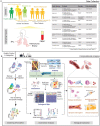
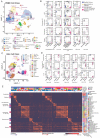
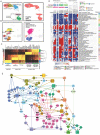
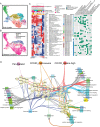

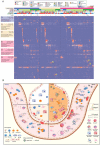
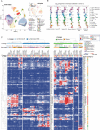
Similar articles
-
An interactive single cell web portal identifies gene and cell networks in COVID-19 host responses.iScience. 2021 Oct 22;24(10):103115. doi: 10.1016/j.isci.2021.103115. Epub 2021 Sep 10. iScience. 2021. PMID: 34522848 Free PMC article.
-
Identifying novel host-based diagnostic biomarker panels for COVID-19: a whole-blood/nasopharyngeal transcriptome meta-analysis.Mol Med. 2022 Aug 3;28(1):86. doi: 10.1186/s10020-022-00513-5. Mol Med. 2022. PMID: 35922752 Free PMC article.
-
Human Nasal Epithelial Cells Sustain Persistent SARS-CoV-2 Infection In Vitro, despite Eliciting a Prolonged Antiviral Response.mBio. 2022 Feb 22;13(1):e0343621. doi: 10.1128/mbio.03436-21. Epub 2022 Jan 18. mBio. 2022. PMID: 35038898 Free PMC article.
-
mRNA-lncRNA Co-Expression Network Analysis Reveals the Role of lncRNAs in Immune Dysfunction during Severe SARS-CoV-2 Infection.Viruses. 2021 Mar 3;13(3):402. doi: 10.3390/v13030402. Viruses. 2021. PMID: 33802569 Free PMC article.
-
Time Series Transcriptomic Analysis of Bronchoalveolar Lavage Cells from Piglets Infected with Virulent or Low-Virulent Porcine Reproductive and Respiratory Syndrome Virus 1.J Virol. 2022 Feb 9;96(3):e0114021. doi: 10.1128/JVI.01140-21. Epub 2021 Dec 1. J Virol. 2022. PMID: 34851149 Free PMC article.
References
-
- Aust G., Sittig D., Becherer L., Anderegg U., Schütz A., Lamesch P., and Schmücking E. (2004). The role of CXCR5 and its ligand CXCL13 in the compartmentalization of lymphocytes in thyroids affected by autoimmune thyroid diseases. Eur. J. Endocrinol. 150, 225–234. - PubMed
Publication types
Grants and funding
LinkOut - more resources
Full Text Sources
Research Materials
Miscellaneous
